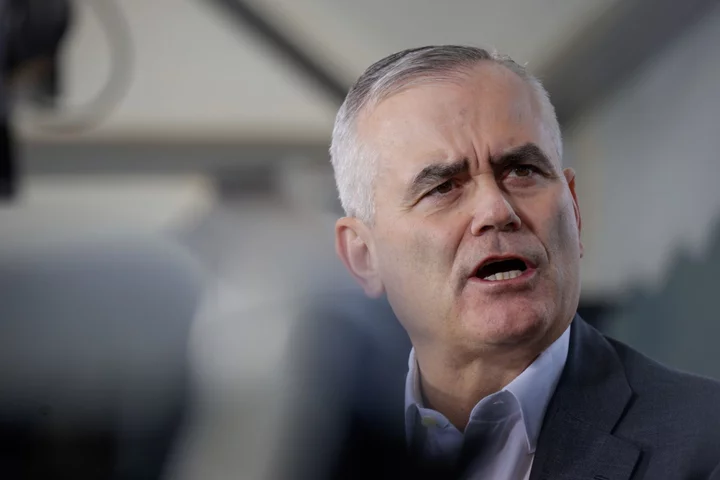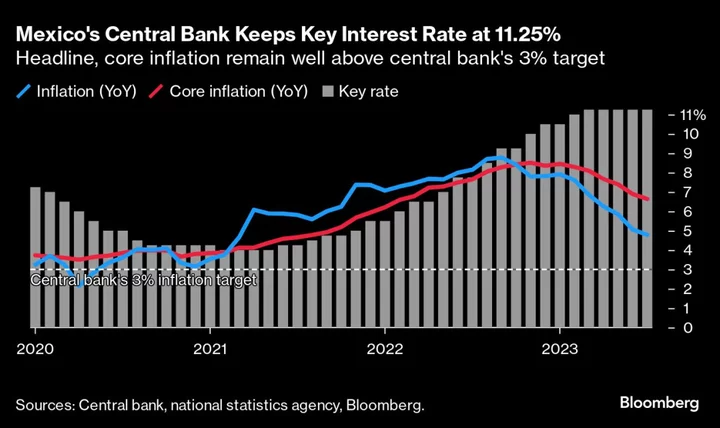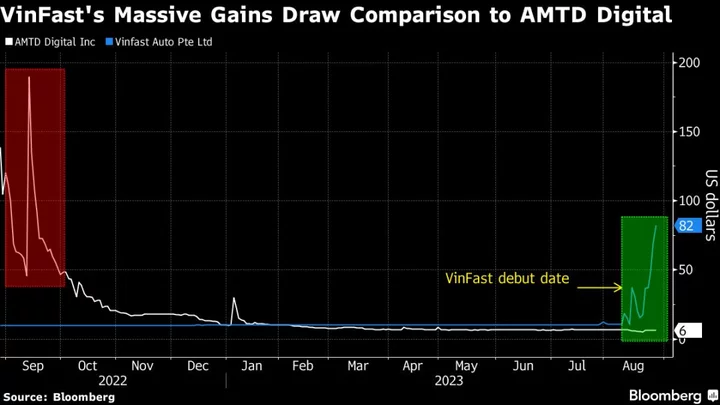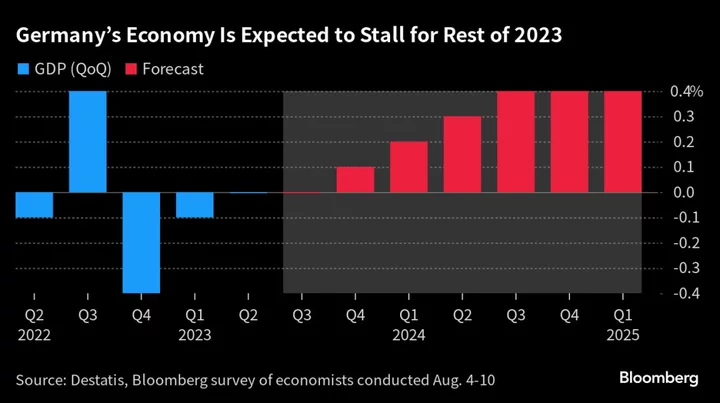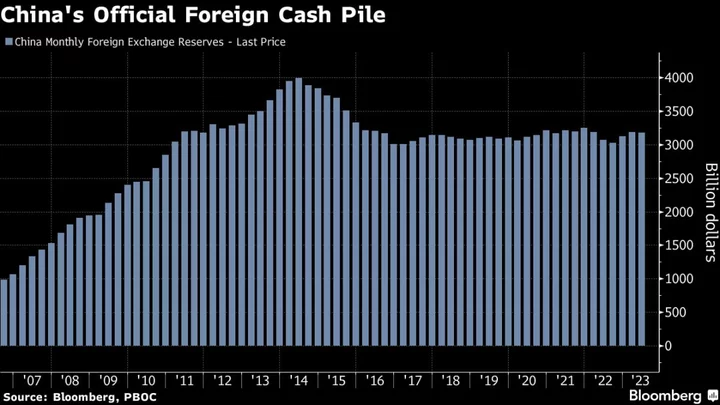Markets, Boaz Weinstein said this week, are “constantly wrong.” Telling which one is most astray right now has become the big challenge for investors facing conflicting signals across asset classes.
Is it stocks, where an advance previously confined to a handful of tech megacaps showed distinct signs of broadening out this week? A $6 trillion rally hangs in the balance. Or maybe it’s bonds, where emanations of gloom abound and bets on Federal Reserve rate cuts are multiplying in a market where volatility is running twice as high as it was just two years ago.
For investors, the potential penalties for being on the wrong side of the trade — essentially, miscalculating the likelihood of a recession — are getting higher with every leg up in the S&P 500, which this week crossed into bull-market territory. JPMorgan Chase & Co. analysts put the cost of mistimed bullishness as high as 20% should equity traders turn out to have misjudged the economy’s path.
“Something has got to give,” said Peter Cecchini, director of research at Axonic Capital. “With equity valuations this stretched in many sectors relative to realistic forecasts for 2023 earnings, we’d bet the give comes from equities.”
The S&P 500 added 0.4% this week to post its fourth straight increase. The tech-heavy Nasdaq 100 trailed, posting its first decline in seven weeks as money flowed to beaten-down areas like banks and small-caps. A gauge of regional lenders jumped 3%, while the Russell 2000 climbed almost 2%.
Defensively positioned money managers have started warming to the rally. In a poll by the National Association of Active Investment Managers (NAAIM), equity exposure just increased at the fastest pace in more than two years. At 90%, the reading was the highest since November 2021.
For his part, Weinstein, the chief investment officer of Saba Capital Management, says getting too caught up in speculation about the economy is a mistake. “Instead of saying, ‘I think there’ll be a recession or there won’t,’ which I kind of howl at the TV screen when I hear that, I feel like you have to think of ranges of outcomes,” he said, speaking at the Bloomberg Invest event in New York.
That translates into a bet against corporate bonds at Saba, premised on the view that subdued yield spread makes a wager against credit too juicy to pass up. For investors who are increasingly all-in on stocks, however, the perils are increasing.
While the S&P 500 has surged more than 20% from its October low, entering what some consider a bull market, the resilience is at odds with ever-growing warnings from the bond market. Yield curve inversion — a widely watched indicator for an economic recession — has worsened over that stretch as long-dated Treasury rates fell further below short-dated ones.
The divide is illustrated by a model kept by JPMorgan that compares each asset’s market pricing versus its implied value based on macroeconomic factors such as inflation volatility. While bonds have reflected persistent uncertainty since February, the stock market is more sanguine, pricing less risk than before the pandemic.
Should equities echo fixed income in acknowledging the risk over inflation volatility, the S&P 500 would be 20% below its current levels, according to the firm’s strategists including Nikolaos Panigirtzoglou.
Of course, seeking a consistent economic message across assets is often a futile exercise as the economy’s trajectory is not the only thing driving prices. A big force in 2023’s equity rally has been euphoria around artificial intelligence supercharging computer and software shares, with the seven largest tech firms accounting for almost all the S&P 500’s year-to-date gains.
It’s also possible that stock traders, after sending equities into a bear market in 2022 amid mounting fears of a recession, are readjusting their expectations for the timing and magnitude of an economic downturn.
In fact, it’s not unusual to see stocks going up in the face of the bond market’s recessional warnings. Using the yield gap between three-month and 10-year Treasuries as a signpost, a study by Leuthold Group found that since the late 1960s, a trader buying the S&P 500 on the first day of the yield inversion and, with perfect timing, selling at the subsequent high could have made anything from 5% to 23%. Those gains averaged 13% over a holding period of roughly eight months.
This time, the yield inversion happened in November, or seven months ago. Since then, the S&P 500 has climbed 13%, matching the average of the previous post-inversion advances.
Coincidence? Perhaps. But Doug Ramsey, Leuthold’s chief investment officer, considers the market’s latest leg higher as another “pre-recessionary rally.” In his view, while yield inversions have correctly forecast all previous eight recessions, stocks tended to defy initial alarms as investors sought to exploit the last window to profits before the eventual bust.
With small-cap stocks and depressed cyclical shares such as banks rising from the dust of late, many market participants are cheering over the broadening in share participation.
Ramsey is skeptical, warning the market could face “a last gasp for this upswing,” given the Fed’s commitment to its inflation-fighting campaign.
In the previous eight instances of yield inversion, the S&P 500 dropped 35% on average from the interim peak to the final low, his analysis shows.
“When the really beaten-down stuff finally joins in, it’s sometimes a sign the party is about to end,” Ramsey said. “And unlike the endless market celebrations of the last decade, this one lacks a punch bowl,” a reference to stimulative Fed policy.
As conflicted as asset moves have been, 2023 is shaping up to be a punishing year for consensus bets. From sell Big Tech stocks to short the dollar and long Chinese shares, Wall Street’s once-hot trades at the start of the year are all faltering.
Even among stocks, a battle is raging. Consider the Russell 2000 and Nasdaq 100, which have taken turns outperforming this month. For six straight sessions, their return gap has exceeded 1 percentage point. That’s the longest stretch of big, listless rotations since November 2020.
Helping fuel a revival in small-caps — stocks that are typically more sensitive to economic swings — is optimism that the economy may avoid a severe recession, with the Fed poised to put a brake on its aggressive monetary tightening.
The central bank is expected to pause interest-rate increases next week for the first time in 15 months and leave policy on hold through December, according to economists surveyed by Bloomberg.
To Emily Roland, the co-chief investment strategist of John Hancock Investment Management, investors had better hold the urge to chase gains because the economic outlook remains murky and today’s winners can easily become tomorrow’s losers.
“We are in this pivot party,” she said. “But my analogy in terms of how to play it, maybe you want to sip on a light beer instead of reaching for the tequila because you might have fewer regrets the next morning.”
--With assistance from Lisa Abramowicz and Carly Wanna.


